THE 4-4-2 WENT FOR BROKE
By Marc Yablonka
Originally published in the National Amvet magazine in 2003.
Author’s note: In the early 1990s, I attended the conference of the Asia Society held in Los Angeles. Many prominent Asian Americans were featured guest speakers. Among them were broadcast journalists Connie Chung and Tritia Toyota, now a professor of communications at UCLA, then a local news anchor at KNBC in Burbank. Also in attendance was the late Senator Daniel Inouye (D-HI), perhaps the most famous veteran of the US Army’s 442nd Regimental Combat Team. Senator Inouye lost an arm during the battle of Colle Musatello Ridge near San Terenzo, Italy on April 21, 1945. I will never forget him ascending the podium to tell the story of how, enroute home to Hawaii after the war, he lay over in San Francisco. Badly needing a haircut, he walked into a barber shop in the city, wearing his Class A uniform, the sleeve to his missing arm pinned to his coat. The barber took one look at him and yelled, “Get outa here you dirty Jap!”
A couple years later, then a stringer for the L.A. bureau of the Reuters wire service, I was ordered to roll to Santa Monica Airport. Senator Bob Dole (R-KS) was flying in (on a FedEx Lear Jet!) to do the Jay Leno show at NBC in Burbank that night. Senator Dole regaled us newsies with quite a few stories at SMO that day. But the one I will never forget is the one he told us about being in the same US Army hospital in Italy as his good friend Danny Inouye. Dole told us that, as he awoke from his own anesthesia, he glanced over at a still very anesthetized Inouye. His eyes followed the tube flowing blood into his future fellow US Senator’s body until they rested on the bag supplying the blood. On that bag were written the words, “Black Blood.” As I documented that press conference in my book Dispatches from My Father’s War, published in 2018 by War Stories Press, “The roots of prejudice still ran deep in the US Army.”
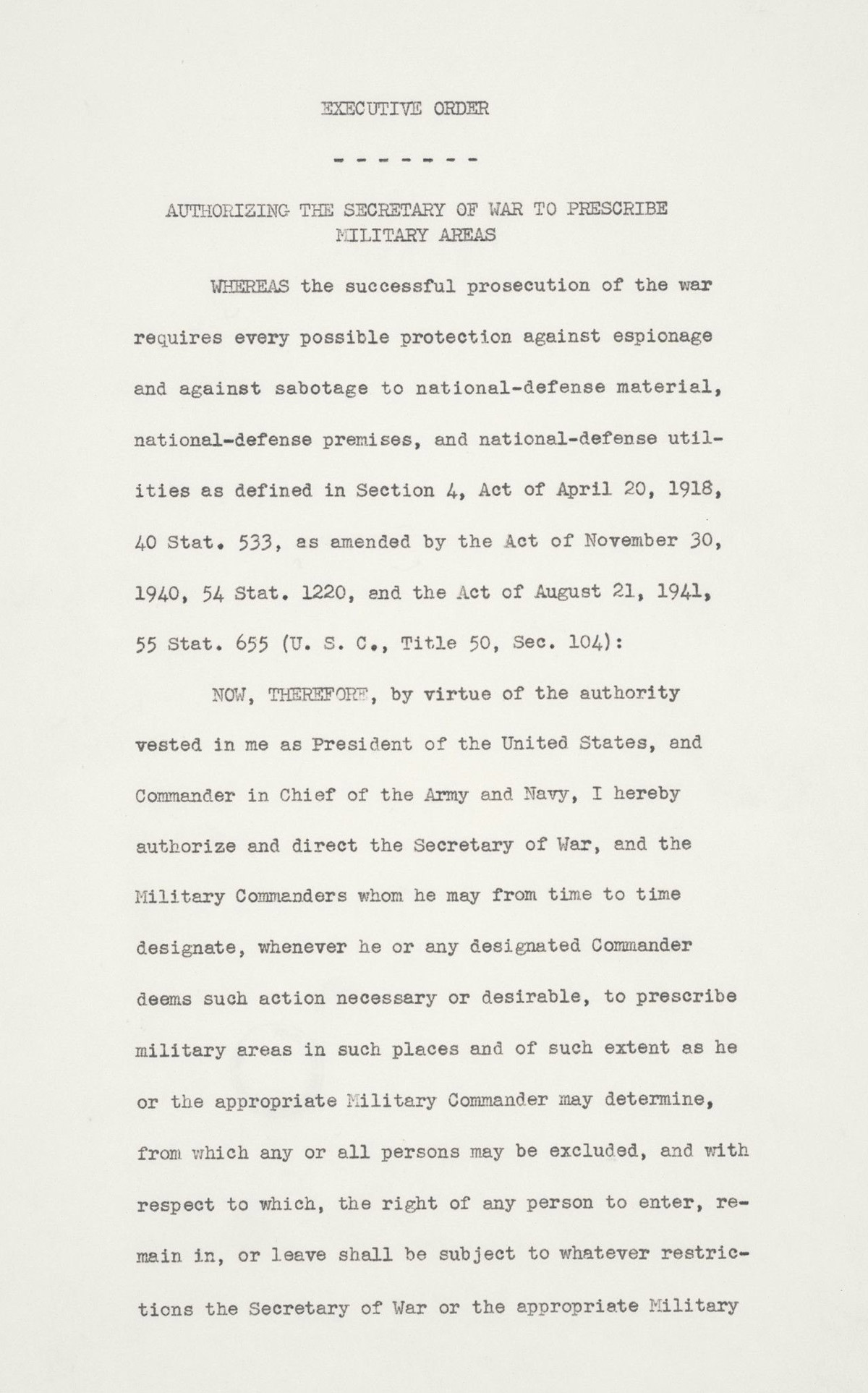
Issued by President Franklin Roosevelt on February 19, 1942, Executive Order 9066 authorized the Secretary of War to evacuate all persons deemed a threat to national security from the West Coast to “relocation centers” further inland. (Photo courtesy National Archives)
Less than two months after Japan attacked Pearl Harbor, every man, woman and child of Japanese ancestry living in the United States was relocated to a series of Internment camps-mainly in California, Oregon, Washington, Idaho, Arizona, Colorado and Arkansas. Many among the 127,000 Japanese Americans affected by President Franklin D. Roosevelt’s Executive Order 9066 were proud U.S. citizens. To supporters of the action, it made no difference; there was a war going on, they felt. Scoffing at the lack of any sabotage on the part of the Japanese-Americans, then California State Attorney General (later Supreme Court Justice) Earl Warren grimly declared, “They’re just waiting for the zero hour to arrive.”
It never did, of course, Meanwhile, for those interned, their desolate existence bordered on imprisonment. Forced to live in wooden barracks covered with tar paper, they shared communal bathrooms and were watched over 24 hours a day by military guards atop watch towers. Despite these conditions, many nonetheless started off their day saying the Pledge of Allegiance.
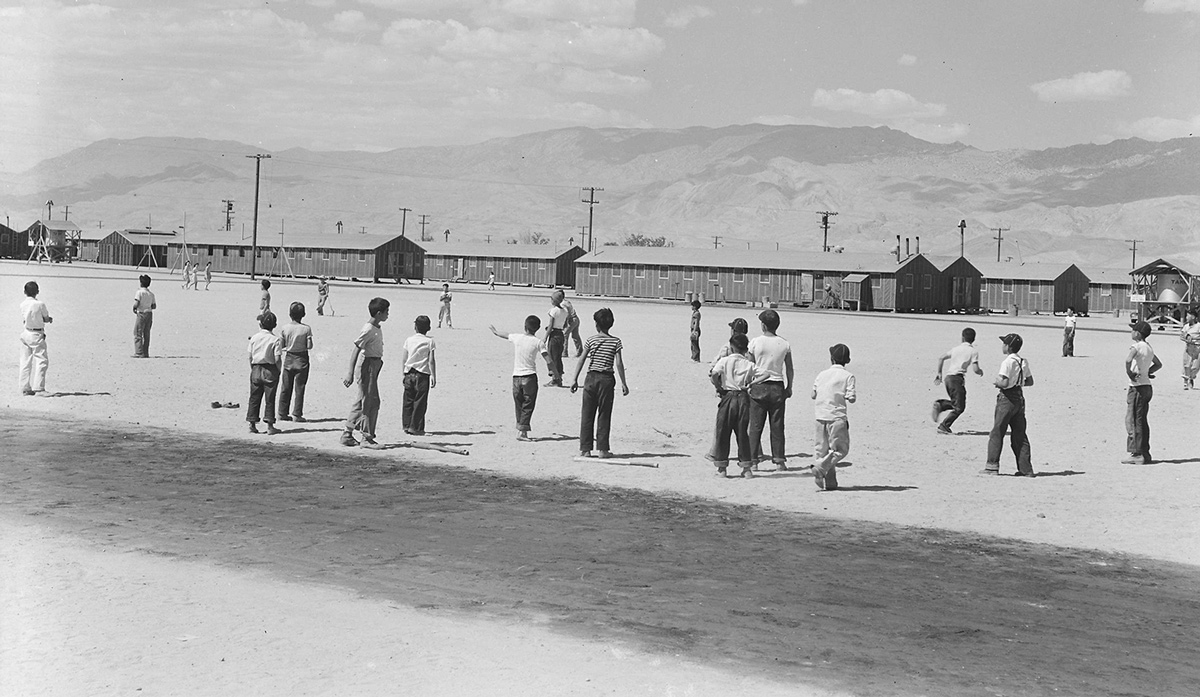
Nisei Japanese boys playing baseball at the Manzanar War Relocation Center. (Photo taken by Dorothea Lange for the War Relocation Authority, courtesy National Archives)
Finally, in March 1943, desperately needing to beef up the Armed Forces, the War Department put out a call for volunteers-to man a U.S. combat unit comprised chiefly of Japanese-Americans. Ten thousand answered it and, ultimately, 6,000 of them were enlisted in the 442nd Regimental Combat Team, later to merge with the 100th Battalion in the European Theatre. Because most of the enlisted came from the place where the Second World War had begun for America, the new unit adopted the popular Hawaiian slogan which remains an American icon even today: “Go for Broke.”
“Everybody wanted to volunteer,” recalled Henry lkemoto, a retired Los Angeles County probation officer, “We wanted to show that we wanted to fight, too.”
“You have to understand that period of time,” added James Mita, a Postal Service retiree. “Everybody was patriotic. We didn’t want to be left behind. If we were true Americans, we had to prove that we were as good as anybody else. When the military accepted me, when I was able to serve, I felt as though I was a whole American again.”
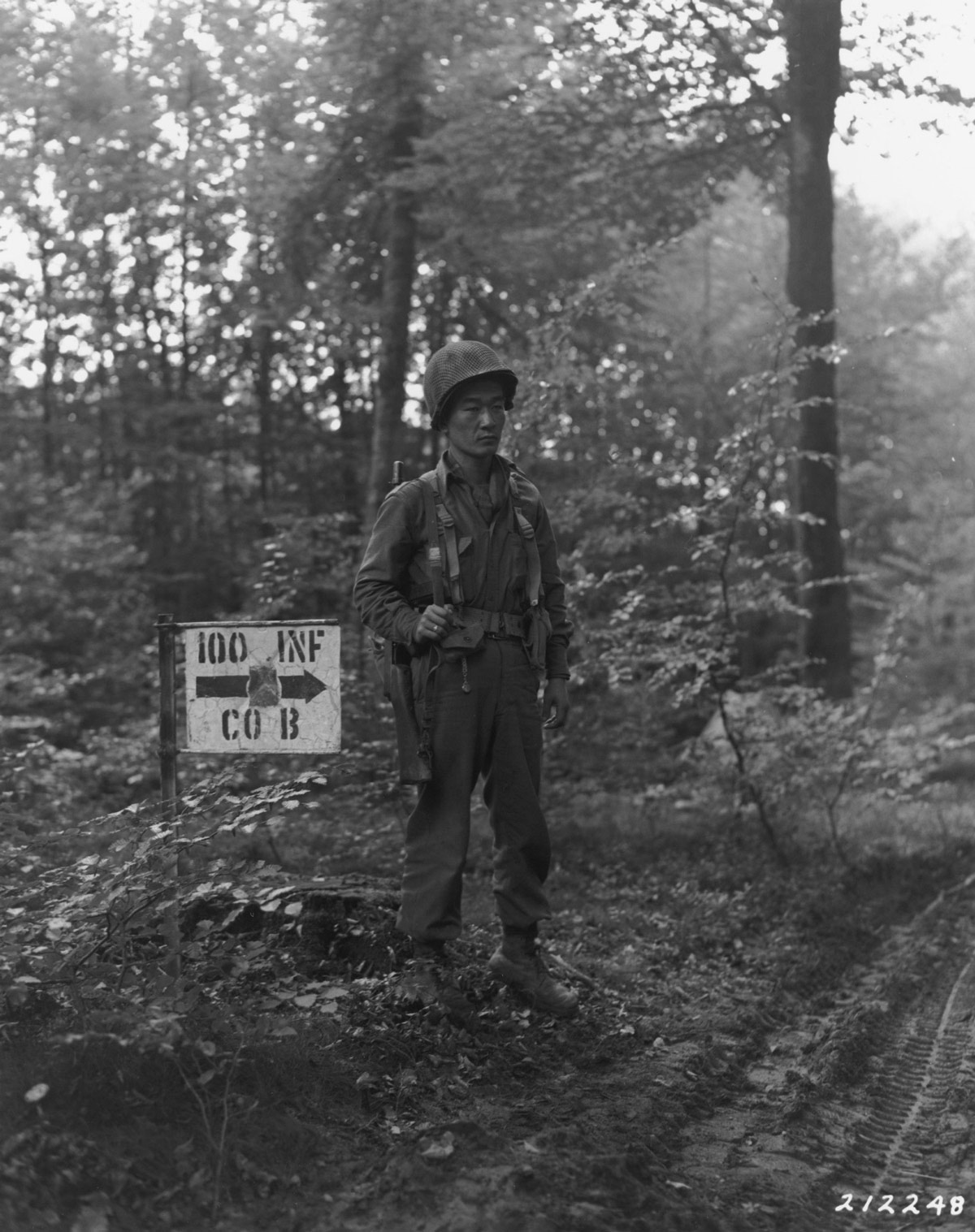
442nd Regimental Combat Team Staff Sgt. James Kawashime standing guard in Chamois, France in 1944. (Photo courtesy National Archives)
Ikemoto would soon get his chance, as would Mita. After training at Camp Shelby, Miss., the 442nd received its baptism under fire in the mountains of Suvereto, ltaly, on June 26, 1944. Over the next 10 weeks, the fighting raged, with the Germans being pushed back, north of the Arno River. In the winter of that same year, the RCT was rerouted to northeastern France where, together with the 36th lnfantry Division, it liberated the French towns of Bruyères, Belmont and Biffontaine in the Vosges Campaign. All told, the men of the “4-4-2,” as it came be called, distinguished themselves in seven major campaigns in Italy and France.
Accounts of their heroics are well documented. In one action, they were called on to help breech the “German Gothic Line” at Mt. Folgorito, Italy, which had held up the Allies for six months. The 442nd broke through German defenses in 24 hours.
Assigned to Gen. Mark Clark’s U.S. 5th Army, the unit became the most highly decorated unit in the history of the U.S. Army for its size and length of service. It received 7 Presidential Unit Citations and 18,143 individual decorations for bravery, including 9,486 Purple Hearts, 21 Medals of Honor, 32 Distinguished Service Crosses, 588 Silver Stars and more than 4,000 Bronze Stars.
Though rarely given credit for doing so, they were the first to liberate Rome at the end of the war and the Nazi concentration camp at Dachau, Germany, in April 1945.
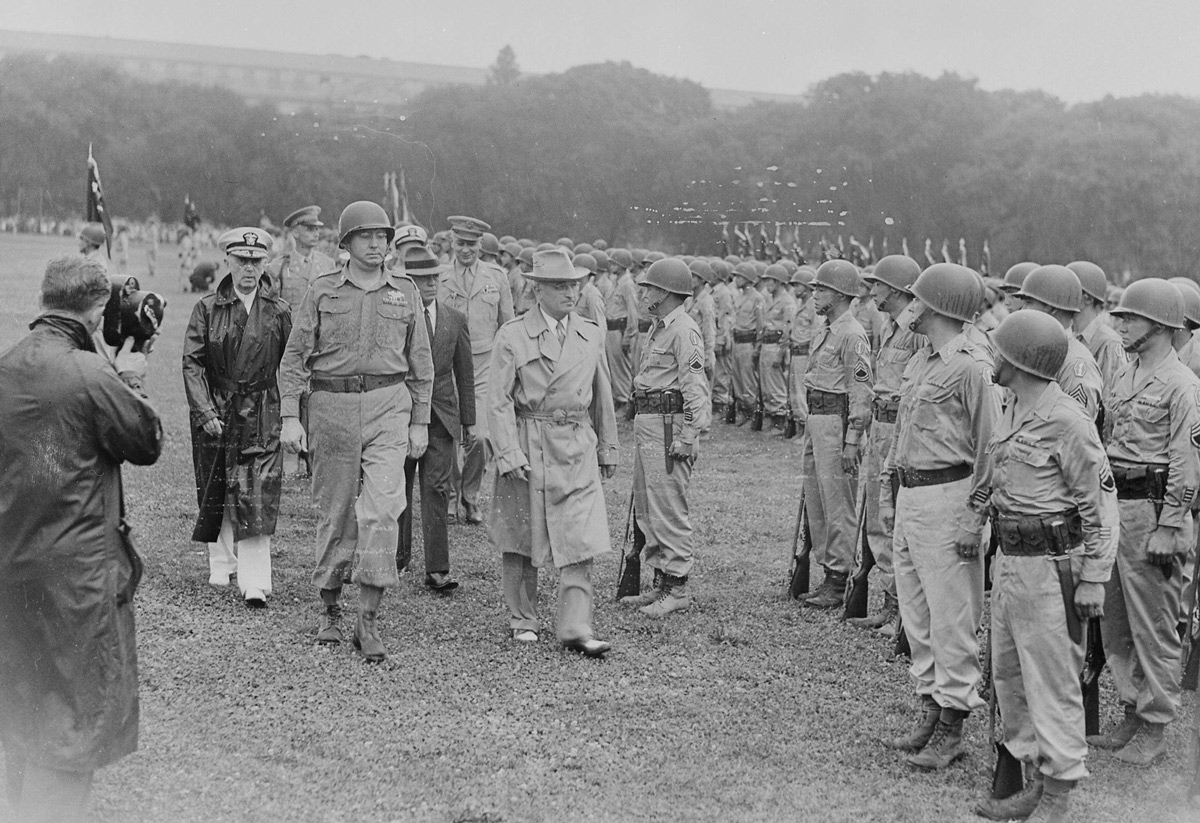
President Harry Truman with members of the 442nd Regimental Combat Team in 1946. (Photo courtesy National Archives).
Edward Ichiyama’s recollection in Japanese Eyes—American Heart— a compilation done by the Hawaii Nikkei History Education Board—of marching into Dachau is particularly poignant:
“As we approached the vicinity of the snow-covered fields, we unexpectedly witnessed a gruesome and pitiful sight; hundreds and hundreds of emaciated, gaunt, malnourished people in black-and-white prison clothing. Their eyes were sunken and their cheeks hollow. They were living skeletons… many were sprawled on the snow-covered ground, unable to walk… we tried to help them, offering whatever food, clothing, water and medicine we had and words of kindness, comfort and compassion,”
The spirit of the 4-4-2’s volunteerism came at a high price. It suffered more than 650 killed in the short time of its activation, and its missing in action were many. At the end of World War II, when he welcomed members of the 100th Battalion of the 442nd Regimental Combat Team home, President Harry S. Truman told them, “You fought not only the enemy… You fought prejudice and won.” Indeed, they had.
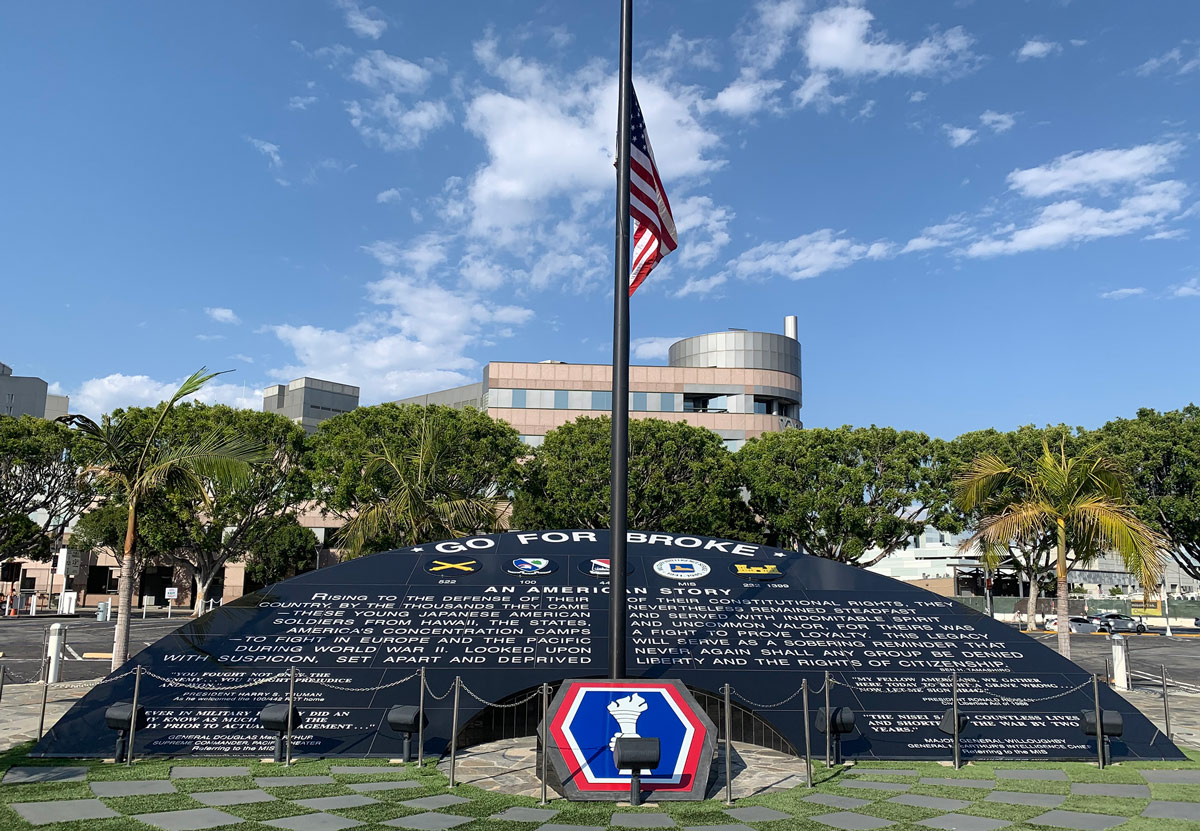
GO FOR BROKE MEMORIAL
Located in Little Tokyo, Los Angeles, California, commemorates Japanese Americans who served in the United States Army during World War II.
Main inscription
GO FOR BROKE – An American Story
Rising to the defense of their country, by the thousands they came – these young Japanese American soldiers from Hawaii, the states, America’s concentration camps – to fight in Europe and the Pacific during World War II. Looked upon with suspicion, set apart and deprived of their constitutional rights, they nevertheless remained steadfast and served with indomitable spirit and uncommon valor, for theirs was a fight to prove loyalty. This legacy will serve as a sobering reminder that never again shall any group be denied liberty and the rights of citizenship.
—Ben H. Tamashiro
Quotations below the main inscription
“You not only fought the enemy . . . you fought prejudice and won.” – President Harry S. Truman as he welcomed the 100/442 RCT home
“Never in military history did an army know as much about the enemy prior to actual engagement” – General Douglas MacArthur, Supreme Commander, Pacific Theater, referring to the MIS
“My fellow Americans, we gather here today to right a grave wrong . . . now let me sign H.R. 442.” – President Ronald Reagan, Civil Liberties Act of 1988
“The Nisei saved countless lives and shortened the war by two years” – Charles A. Willoughby, General MacArthur’s Intelligence Officer, referring to the MIS
ABOUT THE AUTHOR — Marc Yablonka is a military journalist whose reportage has appeared in the U.S. Military’s Stars and Stripes, Army Times, Air Force Times, American Veteran, Vietnam magazine, Airways, Military Heritage, Soldier of Fortune and many other publications. He is the author of Distant War: Recollections of Vietnam, Laos and Cambodia, Tears Across the Mekong, Vietnam Bao Chi: Warriors of Word and Film, and Hot Mics and TV Lights: The American Forces Vietnam Network.
Between 2001 and 2008, Marc served as a Public Affairs Officer, CWO-2, with the 40th Infantry Division Support Brigade and Installation Support Group, California State Military Reserve, Joint Forces Training Base, Los Alamitos, California. During that time, he wrote articles and took photographs in support of Soldiers who were mobilizing for and demobilizing from Operation Iraqi Freedom and Operation Enduring Freedom.
His work was published in Soldiers, official magazine of the United States Army, Grizzly, magazine of the California National Guard, the Blade, magazine of the 63rd Regional Readiness Command-U.S. Army Reserves, Hawaii Army Weekly, and Army Magazine, magazine of the Association of the U.S. Army.
Marc’s decorations include the California National Guard Medal of Merit, California National Guard Service Ribbon, and California National Guard Commendation Medal w/Oak Leaf. He also served two tours of duty with the Sar El Unit of the Israeli Defense Forces and holds the Master’s of Professional Writing degree earned from the University of Southern California.
Leave A Comment